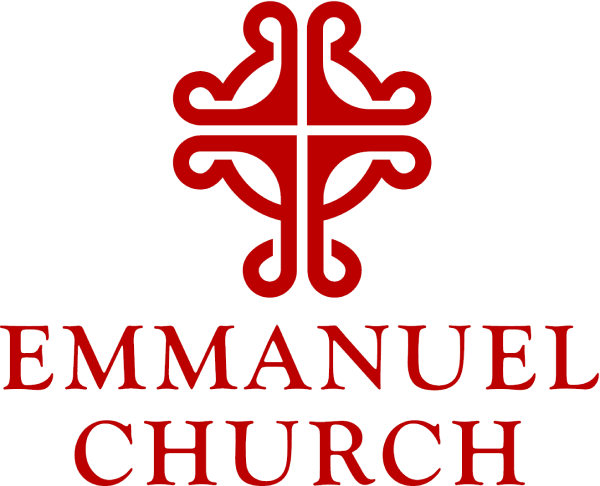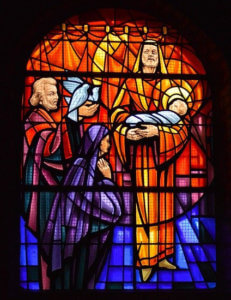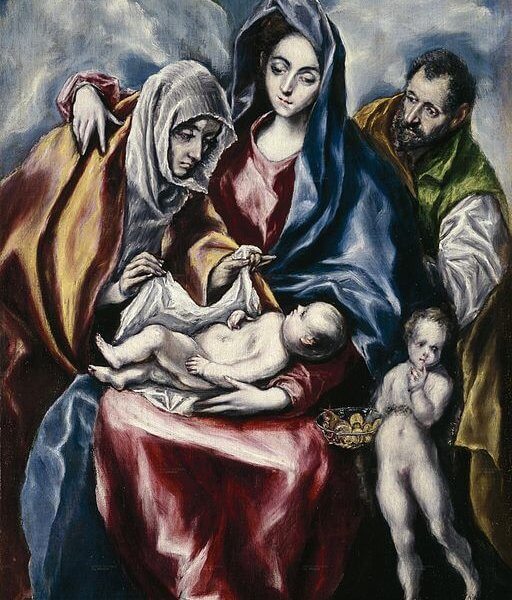
How Do We Meet the Holy?
Today we celebrate the Feast of the Presentation of Our Lord — Mary’s purification and the holy parents’ presentation of the infant Jesus in the Temple. Luke’s gospel tells us that that the Holy Family came up to Jerusalem for this rite of purification that Jewish law required of a mother after childbirth. They were also fulfilling Jewish law requiring them to present their firstborn son to God and designate him as holy.
We still do this purification rite today, although the 1979 Book of Common Prayer — the one that we use now — eliminated the idea that childbirth causes ritual impurity. But we kept the ritual around “the Churching of Women,” as it was called — now referred to as Thanksgiving Upon the Birth or Adoption of a Child. Check out page 439 of your Book of Common Prayer! This purification rite was important in the Holy Family’s time — important enough for Mary and Joseph to have walked all the way from home in Nazareth to the Temple in Jerusalem, at least a 5-day walk if the roads weren’t flooded in the Jordan Valley during the winter rains that are going on now. And important enough for Mary and Joseph to have bought the prescribed pair of turtle doves, or two young pigeons, for the sacrifice at the Temple, as Luke’s gospel tells us they have done.
There must have been other parents and firstborn sons coming into the Temple for this rite. After all, every Jewish family with a boy in it has a firstborn son. But this firstborn son, the newborn Jesus, attracts the special attention of two remarkable people, Simeon and Anna, who tell us in Luke’s gospel that Jesus’ arrival changes everything.
Our gospel today is a pretty short story — about three inches of text when it’s not blown up to eighteen-point font so those with presbyopia (priest’s eyes) can see it. There’s not a lot of room for extra details.
Simeon and Anna
So which details do we get? Twenty-five percent or less of the text refers to the Holy Family. At least 75% of the text in this story refers to Simeon and Anna, and how they meet the holy. We meet Simeon first, and we’re told he is a righteous man. The Holy Spirit rests on him. He lives in Jerusalem, Luke’s gospel says, and he’s guided by the Holy Spirit into the Temple, where he takes the baby Jesus into his arms. He sings the song that we say or sing in Evening Prayer to this day: Lord, you now have set your servant free, to go in peace as you have promised, for these eyes of mine have seen the savior, whom you have prepared for all the world to see.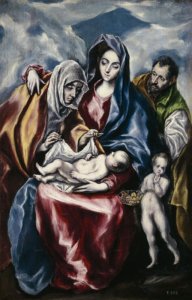
Anna is identified as a prophetess, which on its own is a singular fact. In the Old Testament, I only count Isaiah’s wife, Huldah, Noadiah, Miriam, and Deborah as women prophets, and Anna is the only one I can think of in the New Testament. But this prophetess Anna — every minute of 84 years old, the gospel tells us, and fasting and praying in the Temple every day — arrives just as Simeon is blessing Jesus. Anna praises God and right away starts telling everyone who hoped for the redemption of Jerusalem — which is pretty much everyone living under Roman occupation in first century Jerusalem — that this new baby Jesus was their hope.
Robin Gallagher Branch — a Professor of Biblical Studies who focuses on women in scripture — notes that Luke’s pairing of Simeon and Anna provides an interesting comparison:
Simeon praises the Lord while Anna offers thanks.
Simeon prophesies — at poetic length — but Luke calls Anna a prophetess.
Luke gives us three short verses on Anna that communicate vividly that Anna deserves all the honor bestowed on the elderly in the Ancient Near East. She’s called a prophetess, so she she outranks Simeon, even though he is praised as righteous and devout, and may even be a priest, because he holds the baby Jesus. Anna is the New Testament’s only named female prophetess. Luke tells us Anna’s father’s name (Phanuel) but not her husband’s name, so she stands on her own. Luke also mentions Anna’s tribe, the tribe of Asher, so Anna is among the few New Testament characters with a tribal identification. Jesus is another one.
Simeon’s Prophecy
Simeon focuses on what Jesus the Messiah will mean in the future to all the nations, as well as to the people of Israel. Luke hints that Simeon is old. He has had a revelation that he won’t die, though, until he sees the Messiah. The substance of Simeon’s prophecy — which we call today the Song of Simeon — is that now that he’s seen the Savior, he can die in peace.
But anything Simeon can do, Anna does more and better.
Simeon is old, but Anna is either 84 years old — or, in an equally likely translation of the Greek, she has been a widow for 84 years, which would make her about 105.
This is a lot of specific detail about Anna’s age, which we notice even more next to Luke’s vague hints that Simeon is a senior citizen.
Simeon “lives in Jerusalem”. The Holy Spirit guides Simeon up to the Temple to find the Holy Family. Interestingly, Simeon’s response to seeing the Messiah is to say that now he can die in peace — stop all his work as a holy man.
Anna, however, is right in the Temple all along. She never left the temple but worshiped there with fasting and prayer night and day. She takes one look at the baby Jesus and immediately gets right to work, full of energy at all of her 84 or 105 years. Whatever it is, it doesn’t even matter, because Anna is the Energizer Bunny of the Lord. Right away, Anna speaks about the child to all who were looking for the redemption of Jerusalem, telling them that this new baby Jesus is the one who will provide their liberation from the Roman occupation.
Male-Female Parallelism
American New Testament scholar Ben Witherington III says that the pairing of Simeon and Anna reflects Luke’s penchant for male-female parallelism when he writes about the recipients of divine blessing and salvation. The story of Jesus’ birth is framed by two such stories—that of Elizabeth and Zechariah in Luke 1 and Anna and Simeon in Luke 2.
Interestingly, in both, the woman is portrayed as the more positive example of discipleship. The women are not only more receptive to the message, they are more willing to act upon it, with Elizabeth realizing that her cousin is carrying the messiah and praising God for this blessing and Anna spreading the good news. And with Simeon and Anna, even though Simeon is a righteous man, and the Holy Spirit rested upon him and guided him to Jesus in the Temple, it is Anna who is the tireless prophetess who gets the work of evangelism done.
How do we meet the holy?
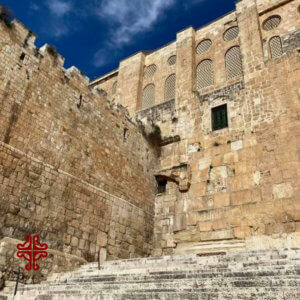 I thought of Simeon and Anna last week as I sat in the winter afternoon sun in one of my favorite holy spots in the Old City of Jerusalem — the ancient stone steps leading up to the Huldah Gates. The Huldah Gates — named after the prophetess Huldah, interestingly — have been walled up since the Middle Ages.
I thought of Simeon and Anna last week as I sat in the winter afternoon sun in one of my favorite holy spots in the Old City of Jerusalem — the ancient stone steps leading up to the Huldah Gates. The Huldah Gates — named after the prophetess Huldah, interestingly — have been walled up since the Middle Ages.
But they are very likely the gates that Mary, Joseph, Simeon, and even the prophetess Anna would have passed through on the way to the Temple Mount — Anna less frequently than Simeon, because, as Luke’s gospel tells us, she prayed and fasted at the Temple pretty much 24/7/365. What do Simeon’s and Anna’s examples tell us about discipleship, and how we respond to Jesus? Like many human beings, even holy ones, in scripture, Simeon and Anna are not examples of good and bad — or right or wrong — responses to the holy. They are different, so we can see our own humanity interacting with God.
On the stone steps to the Huldah Gate that our ancestors in faith would have climbed, I like to touch the right side of the now-walled up gate, where Anna might have touched — or Mary, or Joseph, or Simeon — as they passed through on the way up to the Temple.
Or maybe they were left-handed? I touch the left side too as I imagine that possibility, my hand searching out the memory of Simeon’s and Anna’s hopeful touches, drawn by the Holy Spirit to meet Jesus, a light to enlighten the nations, and the glory of your people, Israel, as Simeon sings.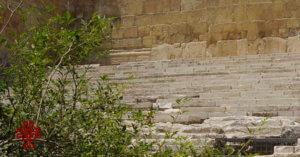
How do we meet the holy? Both Simeon and Anna recognize Jesus as the Messiah and honor him. Simeon’s prophecy is now fulfilled. He’s a holy man, and righteous. He has seen the Savior, so he can relax and die in peace. Anna, measurably and specifically older than Simeon, and a prophetess, just gets to work. Luke writes the gospel this way, trying to get us to notice this.
I think of Simeon and Anna’s hopeful, human touches on that ancient stone now — more than 7,000 miles and 2,000 years away. Like Anna, I’m looking for hope for all those living under the current occupation of Jerusalem and Palestine, especially as the American-made peace plan was announced this week. But it’s hard to see. As the Heads of Churches in Jerusalem wrote in their statement released Thursday, may the resurrection of our Lord from Jerusalem remind us all of the sacrifices to ensure justice and peace in the Holy Land, then and now.
How do we respond to the holy?
Recognizing the holy is the first step. One response is to retreat in gratitude like Simeon, your own best hopes fulfilled. Another is to get the word out to all who are looking for the redemption of Jerusalem — all of us who hope to walk in the Kingdom of God. Amen
